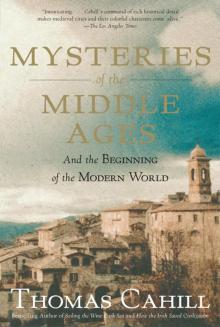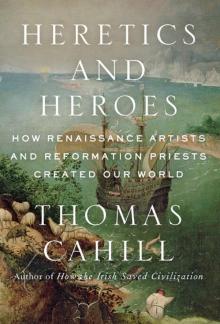- Home
- Thomas Cahill
A Saint on Death Row Page 3
A Saint on Death Row Read online
Page 3
Melamed and Olvera did call another character witness, Sylvia Gonzales, Dominique's juvenile probation officer, who was sympathetic to Dominique and recognized the extremely negative role Stephanie had played in his young life. Sylvia testified briefly to Stephanie's oppressive behavior toward her son as well as to Dominique's character, “easygoing and receptive,” “truthful and cooperative.” But Sylvia was not prepared to testify by Dominique's lawyers, who met her but once—in the hallway just prior to her testimony—and they made little of her testimony.
Far more important was another character witness, a supposedly scientific one. For the sentencing phase of the trial, Melamed called a psychologist, Dr. Walter Quijano, to testify to Dominique's psychological disposition. Quijano, who was born in the Philippines and whose father was of Spanish (not Hispanic) ancestry, has in other cases urged the death penalty for explicitly racial reasons, believing, as he does, that the race of a defendant—if the defendant is black or Latino—is a “statistical predictor of future violence.” In Dominique's case, Quijano, keeping quiet about his racial prejudices, limited himself to telling the jury that Dominique had never developed a normal conscience and could therefore be a future danger to society if he were allowed to live—this from a witness supposedly testifying on behalf of the defendant. Though Quijano had interviewed Dominique briefly, his assessment came not from anything he had learned directly in his interview. Rather, his assessment of Dominique's lack of conscience was a syllogistic deduction: those who grow up in circumstances like Dominique's—that is, without a caring parent—lack a normal conscience; therefore, Dominique lacks a normal conscience.
But in the end, race was hardly absent from these proceedings, as the most damning evidence in support of Dominique's punishment came from his own words. Before he had been charged with murder, he had written a letter from jail to Mark Porter (who had been found by police in the stolen car that Dominique had been driving) in which he suggested a narrative they could propose of their movements, a narrative that would enable them to elude conviction (“how to get our case dropped or at least dropped down”). The letter is partly written in ghetto-speak, perhaps because eighteen-year-old Dominique thought he was being cool but also perhaps for the sake of rendering it difficult for any authority intercepting the letter to make sense of it. It begins playfully: “What's up damn fool?” The rest of the letter is the “story” (whether accurate, invented, or somewhere in between, I cannot verify) of what Dominique and his friends were doing the night of the murder, mostly looking for girls and getting into arguments with other boys. The letter ends casually with an expression of Dominique's unconcern as to whether Porter and the others will go along with this or not: “I don't care if a nigga with me or not ‘I forever be a trigga happy nigga.’” To me, this looks like a pose of unconcern and bravado, masking anxiety.
The last words, a quotation from a then popular rap song, “Trigga Happy Nigga,” by a Houston group, the Geto Boys, were placed in double quotation marks by Dominique—a plain signal from the detail-oriented author of the letter that he is quoting someone else's words. Read aloud in court by the prosecutor, however, these words signed Dominique's death warrant. The members of the jury, needless to say, were not informed that what they were hearing was a literary quotation, designated as such. By his own words, Dominique had convinced the jury of the murderous danger that society would be “forever” subjected to, if he were allowed to live.
Normally in a court of law, a letter is read aloud after its recipient has testified that he received the letter and identified from whom it came. But the presence of Mark Porter on the witness stand might have pushed the case into unpredictable byways. He almost surely knew things that the prosecutor did not wish the jury to hear, things that might have bearing on Dominique's possible innocence (such as that all the codefendants knew one another, one of many facts kept from the jury). The prosecutors found a simpler course for introducing Dominique's letter: they asked his mother to identify his handwriting, which she did. On July 9, 1993, a Harris County jury found Dominique guilty of capital murder. On July 14, following the punishment hearing, the court sentenced Dominique to death.
Though the forces of law in Harris County are devoted to executing Death Row inmates with as much dispatch as possible, their eagerness is slowed somewhat by the venerable practice of appellate review, enshrined in the Texas state constitution and to which they owe at least formal loyalty. Over the years to come, Dominique would spend as much time as he could learning the intricacies of the law and of the legal processes by which he had been convicted and sentenced. Needless to say, his interest was hardly academic or disinterested. He needed to learn “the game,” as he called it, the rules of which he had barely comprehended before and during his trial. For a long time he figured that there must be a legal key that would fit his case, that could unlock his cell and send him back to freedom.
He was held during these years in Death Row cells in two different prisons, at Huntsville, then from mid-1999 at Livingston (where he was held—as were all Death Row prisoners—in solitary confinement); and occasionally and for relatively short stays he was brought to the Houston jail. He had plenty of time for legal study. He met occasionally with one lawyer or another who was willing, usually for a brief period of time, to take up his case pro bono, that is, without compensation. On September 11, 1996, the Texas Court of Criminal Appeals (CCA) affirmed Dominique's conviction and sentence on his direct appeal. On November 13, it denied Dominique's petition for a rehearing. On April 28, 1997, the United States Supreme Court denied his petition for a writ of certiorari, that is, an order to call up and review the decision of the lower court. That August 29, Dominique filed an application in the state trial court for a writ of habeas corpus, which is an order to produce the prisoner in court for the purpose of investigating the lawfulness of his imprisonment. Its purpose, as used in the appeals process, is to uncover ineffective assistance of trial attorneys, misconduct by prosecutors or police, and previously unavailable evidence of innocence. Nearly three years later—on May 31, 2000—the CCA at last denied Dominique's application.
That these years were hard on Dominique is almost too obvious to say. He began his long imprisonment as little more than a boy, a street kid whose understanding of the world and its ways was severely limited both by his youth and his peculiar experiences. Over and over, he would say to anyone who would listen that he was innocent of the charge they convicted him of. For this reason he had rejected the offer prior to his trial of a thirty-year sentence if he would confess to the murder. But he also stated firmly that he would not become “a snitch.” The impression he left was that he knew the identity of the shooter but would not identify him. He would speak darkly of those who had turned against him to save their own skins, but even this accusation was broached without his naming identifiable actors. Again and again, he reminded his attorneys that witnesses to the robbery spree that preceded the Lastrapes murder had spoken of three boys, not four, and he pressed the attorneys to locate the relevant videotapes made by the stores the robbers had passed through or near, including the videotape from the convenience store in front of which the murder had occurred. These, he claimed repeatedly, would establish his innocence.
He did admit being part of a gang of robbers on October 17, when the victim related to the police that one of the robbers apologized for what they were doing and thanked the victim. “What kind of robber tells a victim I'm sorry and thank you? One who didn't want to see any harm come to them. Someone like old friendly-ass me.”
Through the worst of these years, Dominique kept his sense of humor, though he often lost his temper. As year followed year without the hint of a reprieve, he snapped occasionally, sometimes more than occasionally, at friend and foe alike and certainly at his lawyers. For several years, he signed himself “Stumpa,” his street moniker and the name under which he had performed aggressive, foul-mouthed rap songs (for which he had, just prior to his arrest, been off
ered a recording contract). For a while he tried to be a Muslim and wrote his name as “Dominique Green-El.” But these glints of black-power rage tended to alternate with his natural optimism, his playfulness, and his capacity for enjoying the world, even the bit of it he could experience from his prison cell.
Through these years, he had a true friend on the outside, Jessica Tanksley, the delicately beautiful girl he had fallen for two years before he lost his freedom—and who is listed in court documents (with her assent) as Dominique's “common-law wife.” Their correspondence is dramatic and humane; and though only Dominique's letters survive in quantity, we can hear Jessica's voice, as Dominique quotes occasionally from her letters. Aint nobody ever told me things like you have. Like ‘you know where home is.’ Or tell me they love me and really mean it like you do. I aint never had anyone love me like you do…. And everytime you write me I continue to feel more needed and wanted. So when I come home to you, I want to be ready for you. And now I got all the time to prepare.”
There are letters so intimate that to quote from them here would be a violation of privacy, but a paragraph from one of the less steamy ones will give you an idea: “Have you ever had a dream where me and you are together and I am kissing you, or you are kissing me? We slowly touch each other and hold each other. As I gently caress your skin that's so delicate and slowly move myself up to your breasts and start to nibble and kiss them and you. Then I feel you rub your fragile hands up my back and onto my face. I feel your hands softly rubbing up against my face. So I go down to embrace your lips and taste your breath and lick your tongue. But I wake up to find my own hand rubbing against my face. A pillow as the face I soon was to embrace. A sheet as the hand rubbing down my back. And a radio is the voice of you I imagined to hear.”
To Jessica Dominique speaks openly of his worst fears: “I have visioned and thought about my own death over and over. And I know that when or if they take me to deathwatch to put me to sleep. Once my eyes close they will never open again. And I will only have three minutes to watch my life pass before my eyes. Watching all those moments I labeled precious, remembering all the things that brought me happiness, and also watching all my mistakes. Three minutes to recap and review my life.
“And not one time have I ever cried. I cried inside because the pain of being here is starting to kill me. But I do know that if I do have to go to deathwatch I wont show the pain then either no matter how bad it hurts.
“Baby, the shit fucks with me everytime I think about it. But I know that no matter what I wont hurt myself by becoming a snitch like these folks want me to be. Because then everything I have done or did would be a complete lie. That's why I cant say nothing and wont ever say nothing.”
But Jessica is growing up in ways almost unimaginable to Dominique. In the summer of 1994 she leaves Houston to attend Xavier University in New Orleans. Her visits to Dominique, which had never been frequent because of the maddening difficulties that the inaccessibility of prisons places in the way of poor Texans, become even fewer. Soon she is writing about her courses and her reading in ways that leave Dominique in the dust. He is jealous and even confesses dislike of her then favorite writer, the long dead W. E. B. Du Bois, because she likes him too much (“—and I don't take second place for no one!”).
In August 1999, however, this extraordinary correspondence comes to an end. Jessica, her bachelor's degree in hand, is heading to Havana to study medicine at the Latin American School of Medicine, having been granted a full scholarship by the Cuban Ministry of Public Health. Dominique, knowing that communication between a Death Row prisoner and a Havana resident will be almost impossible (and would subject Jessica to unwonted attention from the U.S. State Department), releases her from all obligations to him: “I wish you knew how hard this is for me, but for some small reason I think you do. Just like I think you knew I would eventually end up writing this letter.” Just before this, he had written a harsh letter. But, “no matter how much I tried to make it seem like me, that last letter to you was someone I'm not. I know, and you know. I am a pussycat at heart. I ain't no hardcore muthafucka—although I wish I was. Thankfully who I am truly is a secret. A secret that can only exist between me and you. If anyone else knew, my bad boy image could end up being destroyed. Who knows I could cause a scandal and make these niggas here want to impeach me, like I was the president of some gotdamn body.” (Earlier that year, President Bill Clinton had been acquitted of the impeachment charges against him.)
The self-deprecating humor cannot entirely obscure the immense generosity of this act of farewell. With Jessica gone from his life and his imprisonment entering its seventh year, Dominique, refusing to sink into despair, turns more than ever to his fellow prisoners and to the legal thicket of his case.
∗ The abysmally sloppy press release from the Office of Attorney General lists the date as January 5, 1992—before the murder occurred. The legal record contains not a few such errors.
3
The Community of Sant'Egidio, based in Rome, is one of the very few great religious phenomena of our time. Most of us are so weary of fraudulent religious phenomena—the fake saints molesting altar boys in the sacristy, the preaching scoundrels, the rip-off charities, the feel-good evangelists who promise us both God and money—that we may have come to view all religious movements, perhaps especially Christian religious movements, with suspicion. When I first encountered Sant'Egidio, I kept asking myself if they could possibly be what they seemed to be. Any second now, I supposed, the clay feet would show themselves, peeking out beneath the concealing gown of righteousness. But now, having known many members of the Community for many years, I can report that they are in the main the real thing—the thing they say they are. I would like to spend a few pages telling you more about them because, despite their great distance from Texas Death Row, they are closely woven into the story of Dominique's life.
They started life as a ragtag assortment of Roman high school students who, inspired by the student protests of 1968, decided to meet in the evenings with the intention of becoming better friends and of finding ways to influence their society for the better. Soon enough, they discovered in the four gospels of the New Testament a sternly simple way forward. Jesus's repetition of the ancient Hebrew command, first articulated in the Book of Leviticus—“Thou shalt love thy neighbor as thyself”—became their program. They would obey this command by offering friendship—friendship to one another and to anyone else who fell across their path, especially anyone in need. (The Italian word for “friendship,” amicizia, is built on amico, the word for “friendly” and “friend,” which in turn is built on amare, Italian for “to love.” So in Italian, as in the Latin that is Italian's predecessor, Jesus's command to love one's neighbor is more obviously a command to friendship than it is in English.) This was their antic “plan,” a little absurd even to themselves. Smart, entitled middle-class kids, they were not entirely unaware of the potential ironies of simplicity, of how hollow their approach would sound to the cynical ears of fashionable Rome.
But they persevered. As they began to grow into a larger organization, they formed additional meetings throughout Rome, then throughout Italy. Often, the church halls where they tried to meet were shut to them by priests who thought their youthful spontaneity and priestless informality smelled of Protestantism. Soon enough, however, there were Sant'Egidio communities in most European countries, then in Africa, Asia, and Latin America, the United States and Canada being the only region where Sant'Egidio remains relatively unknown. Though the headquarters of Sant'Egidio, close by the great Basilica of Santa Maria in Trastevere, keeps no record of numbers, there must now—forty years after their first meetings—be close to sixty thousand members throughout the world, perhaps less than half of them in Italy. Anyone who wishes to become a member, no matter his or her religious affiliation or lack thereof, national/ethnic background, or sexual orientation, is welcome. Anyone who wishes to participate in one or another of the Community's activitie
s without becoming a member is also welcome.
All the communities meet for a prayer service, usually several times a week, that has scripture reading and a reflection by one of the members as its center. The chanted psalms and hymns they sing, though characteristic of them, seem inspired especially by the chants of Russian Orthodoxy, as is their use of an icon of Jesus that serves as the focus of attention. But the service, wherever it is enacted, retains a simplicity and an intensity that cannot but impress even the casual visitor. For many years, the original Roman community met for prayer in the Church of Sant'Egidio, a former convent of enclosed nuns that was given to them and from which the movement took its name.
Now, having outgrown its own church, the Trastevere chapter meets for prayer each night in the large Basilica of Santa Maria, which is close to an apartment my wife and I own and where we spend a part of each year. Santa Maria, extraordinarily beautiful, is a mostly twelfth- and thirteenth-century building whose foundations are as ancient as the fourth century, when Christians first emerged aboveground to take their places as equal citizens of Rome and began to build the distinctive edifices that would ever after characterize the great city.
To stop at a description of the Community's prayer would be to falsify these people, for it is the works of Sant'Egidio at least as much as the prayer that distinguishes them. Though the original community in the heart of Rome contains many middle-aged members (as the students of ‘68 have grown gray and sometimes bald), its ranks have been continually replenished by people in their teens and twenties. Other satellite communities, of which there are more than a hundred in and around Rome, are more specialized: communities of the elderly, of poor working people, of gypsies. In each community, friendship with those in need takes precedence and consumes many hours of donated labor. Each night in Trastevere, for instance, fifteen hundred homeless people are fed at sit-down dinners served with graciousness and even style. Likewise, hundreds of substantial bags of groceries are distributed each week. The Trastevere community runs three refuges for abandoned old people, two AIDS hospices, a home for abused and abandoned children, and after-school programs for immigrants and others in the poorer parts of the city. It even runs a delightful, inexpensive restaurant—gli Amici (or Friends)— in Piazza di Sant'Egidio, staffed entirely by mentally handicapped adults.

 How the Irish Saved Civilization
How the Irish Saved Civilization The Gifts of the Jews
The Gifts of the Jews A Saint on Death Row
A Saint on Death Row Mysteries of the Middle Ages
Mysteries of the Middle Ages Sailing the Wine-Dark Sea
Sailing the Wine-Dark Sea Heretics and Heroes
Heretics and Heroes Desire of the Everlasting Hills
Desire of the Everlasting Hills